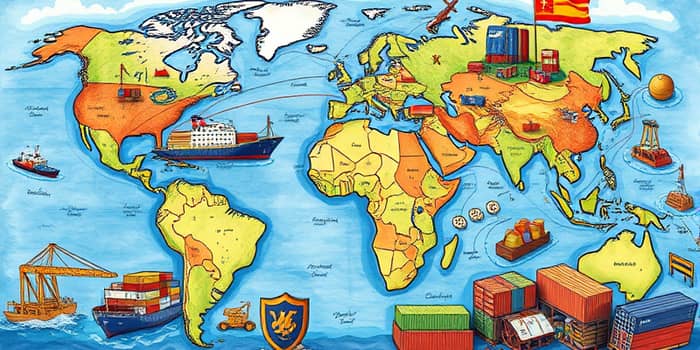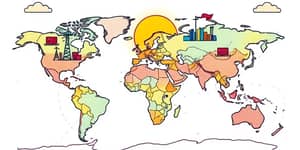In a world increasingly defined by cross-border interactions, the clash between open markets and protective policies shapes the destinies of economies and communities. By weighing the forces of globalization against the pull of protectionism, we can chart a path that fosters prosperity and resilience.
Defining the Contending Forces
Globalization refers to the process by which countries forge deeper ties through the exchange of goods, services, information, and culture. Driven by technology, efficient logistics, and liberalized trade agreements, it expands markets and drives specialization, creating consumer benefits and stimulating innovation.
Conversely, protectionism encompasses government measures—such as tariffs, quotas, and subsidies—designed to shield domestic industries from foreign competition. While intended to preserve jobs and enhance security, these tools can introduce market distortions and inefficiencies.
Historical Evolution and Current Trends
The late 20th century ushered in an era of hyperglobalization, as trade barriers fell and global supply chains flourished. However, the 2008–09 financial crisis triggered a plateau in international trade expansion. Brexit, the US–China trade war, and pandemic-induced supply chain shocks have all fueled a resurgence of protective instincts.
Policymakers now grapple with the need for strategic autonomy in critical sectors, prompting shifts toward de-globalization in areas like medical supplies and semiconductors. At the same time, many businesses and consumers still reap the rewards of interconnected markets.
Economic Impacts: Growth and Cost
Globalization delivers a host of economic benefits:
- It attracts foreign direct investment, bringing new technologies and skills.
- It fosters competitive pressure that lowers consumer prices and raises quality.
- It enables firms to tap into diverse talent pools and specialized suppliers.
- It enhances resilience by allowing countries to buffer domestic shocks.
Protectionist measures, however, impose significant costs:
- They result in higher prices and reduced consumer choice by imposing tariffs and quotas.
- They provoke retaliation, disrupting export-oriented industries.
- They create operational complexity and unpredictability in supply chains.
- They foster complacency in sheltered industries, stifling innovation.
Who Wins and Who Pays the Price
While certain politically well-connected sectors may secure temporary gains, the broader economy and consumers typically bear the burden of higher costs and inefficiencies. Understanding these trade-offs is crucial for informed policymaking.
Social and Political Ramifications
Trade policy reverberates beyond balance sheets, influencing employment, public sentiment, and national security priorities. Protectionist tactics can carry exorbitant costs per saved job and fuel resource nationalism, as governments seek to control strategic inputs.
- Domestic employment gains in one sector may mask losses elsewhere.
- Localized tariff effects can sway electoral outcomes.
- Export controls on critical materials spark global tensions.
Looking Ahead: Balancing Resilience and Opportunity
Experts caution that while some degree of self-reliance is prudent, overzealous protectionism risks eroding the competitive edge of vital industries. The challenge lies in striking a balance between national resilience and global efficiency.
Moving forward, nuanced strategies will be essential. Policymakers and business leaders must collaborate to ensure supply chain security without forsaking the dynamism that open markets provide.
Strategies for Navigating the Trade Landscape
Businesses can fortify their positions by diversifying supplier bases, investing in technology-driven productivity gains, and engaging in constructive policy dialogues. Consumers, in turn, can advocate for transparency and competitive markets through informed choices and civic participation.
Ultimately, long-term prosperity depends on embracing innovation, fostering adaptable value chains, and maintaining a vision that transcends short-term political gains.
Conclusion: Charting a Course Forward
The debate between globalization and protectionism is not a zero-sum game. By understanding the complex interplay of benefits and risks, stakeholders can craft policies that nurture inclusive growth, fortify strategic capacities, and sustain the dynamic exchange of ideas and resources that underpin global progress.
As we navigate this intricate landscape, a commitment to cooperation and evidence-based decision-making will illuminate the path to shared prosperity.
References
- https://www.globalbankingandfinance.com/globalization-vs-protectionism
- https://moderndiplomacy.eu/2024/09/20/the-current-trend-of-de-globalization-protectionism-and-resource-nationalism/
- https://library.fiveable.me/principles-econ/unit-34
- https://www.drishtiias.com/daily-news-analysis/protectionism-vs-globalization
- https://www.onyxsi.com/vantage-point/the-economic-consequences-of-protectionism-more-than-just-inflation/
- https://www.imf.org/external/np/exr/ib/2008/053008.htm
- https://www.worldbank.org/en/news/feature/2023/08/29/protectionism-is-failing-to-achieve-its-goals-and-threatens-the-future-of-critical-industries










